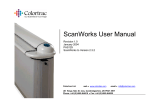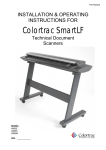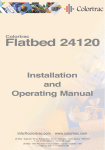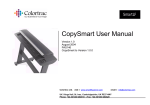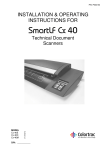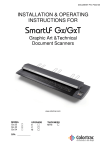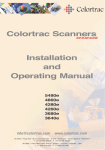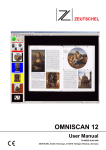Download Colortrac Flatbed 24120 Specifications
Transcript
Colortrac Ltd PRODUCT SALES GUIDE COLORTRAC FLATBED 24120 24” x 36” SCANNER V1.1 JUNE 2003 / PAS 102 UK office: Colortrac Ltd Kings Hall St Ives Business Park St Ives Huntingdon Tel: +44(0) 1480 464618 Fax: +44(0) 1480 464620 email: [email protected] US office: Colortrac US 17301 West Colfax Avenue Suite 165 Golden Colorado CO 80401 Tel: +1 303 973 6722 Fax: +1 303 973 7092 email: [email protected] China office: ACTion Imaging Solutions Beijing Room 4-B1B Building No.7 Section 3 Century City HaiDian District Beijing 100089 Tel: +86 10 51988928 Fax +86 10 51988927 ACTion Imaging Solutions is the trading name of Colortrac Ltd and Colortrac Inc. Colortrac Ltd Registered no 2443067. Registered Office Kings Hall St.Ives Business Park St. Ives Huntingdon Cambridgeshire Colortrac Inc. (US Office) is a wholly owned subsidiary of Colortrac Ltd. Colortrac 24120 Product Sales Guide Contents 1 About this Product Sales Guide ................................................................................................. 1 2 Product Introduction & Overview................................................................................................ 2 2.1 Product Introduction .............................................................................................................. 2 2.2 Operability............................................................................................................................. 3 2.3 Document fading ................................................................................................................... 3 3 Technical Description ................................................................................................................ 3 3.1 Technical Highlights .............................................................................................................. 5 3.2 Depth of Field........................................................................................................................ 6 3.3 Variable object distance: ....................................................................................................... 6 3.4 Fixed object distance:............................................................................................................ 6 3.5 Target Market........................................................................................................................ 7 4 Other competing book and flatbed products............................................................................... 9 4.1 X,Y Scanning Head Flatbed scanners ................................................................................... 9 4.2 Planetary book scanners with boom mounted CCD ............................................................. 10 4.3 Book scanners using full paper width traversing CCD .......................................................... 11 4.4 Hybrid book scanners with traversing CCD head and planetary boom CCD ......................... 11 Specification and Performance ........................................................................................................ 12 6 Safety Advice .......................................................................................................................... 12 7 Scanworks Enhancements ...................................................................................................... 13 7.1 Operational ......................................................................................................................... 13 7.2 Firmware changes............................................................................................................... 14 7.3 Image editing ...................................................................................................................... 14 7.3.1 Join Images (for ‘flat on the glass’ scans ) ................................................................... 14 7.3.1.1 Overlay joining........................................................................................................ 14 7.3.1.2 4 Point joining ......................................................................................................... 16 7.3.2 Cut Overlap ( for ‘off-the-glass’ scans )........................................................................ 17 8 Demonstration Tips ................................................................................................................. 17 8.1 Shipping Considerations:..................................................................................................... 17 8.2 Preparing the 24120............................................................................................................ 18 8.3 Know what the customer needs from the demo ................................................................... 18 8.4 Know the Unique Selling Points of the flatbed...................................................................... 18 8.5 Notes: ................................................................................................................................. 19 Colortrac 24120 Product Sales Guide 1 1 About this Product Sales Guide This Product Sales Guide provides valuable information about the new Colortrac 24120 Flatbed Scanner. As well as an introduction to the product, this guide talks about the design concepts used in the 24120 and the new features now built into Scanworks software specifically for this model. Information is provided about market competition and also there are some ideas on how to sell and develop a successful demo strategy for the flatbed. This document is intended for members of the Action Imaging Solutions worldwide sales force, their distributors and dealers. By working through the sections of the Guide we hope it will provide an understanding of the new product and how it can be positioned in the non sheet-feed large-format scanner market. Colortrac 24120 This guide has been compiled by the Marketing department of ACTion Imaging Solutions / Colortrac Ltd. If there are any features you feel need adding or require further explanation then please contact Declan Tyler, Marketing & Sales Dept. Colortrac, UK. email: [email protected] Colortrac 24120 Product Sales Guide 2 2 Product Introduction & Overview 2.1 Product Introduction The Colortrac 24120 Flatbed Scanner builds on the highly successful technology used in the Series 4 ‘sheet-feed’ scanners. The 24120 scanner is aimed at the Fine Art Reproduction, Image Capture and Archive markets where there is a need for a scanner which does not ‘pinch’ the original in order to scan it. A clear advantage of the flatbed concept is that the original doesn’t need to be rectangular or more importantly of uniform thickness. The document doesn’t have to meet the requirements of the scanner transport system because unlike a sheet feed, originals do not need to move. The optics inside the 24120 scanner move instead. This immediately removes the risk and the nagging question which many a scanning operative ask themself when attempting to use a sheet-feed scanner for specialist work. “ Will my original be damaged by the scanning process ?” Sheet-feed scanners are used everyday to digitise paper drawings and convert them into a digital form which can be accessed across computer networks, allow them to be stored and retrieved and permit them to be reproduced on paper or viewed on a screen. These documents may not be especially valuable in themselves but their value is often enhanced once they become ‘digital’. Example of an architectural paper drawing before scanning. Discoloured and cumbersome drawings like these take up a lot of storage room. To distribute or copy these can be very time consuming Example of part of the same drawing as a digital black and white file ready for archiving or CAD conversion. The electronic form is small (less than 500kb) and can be emailed or printed with ease Many fragile and valuable documents cannot be scanned using sheet-feed scanner technology in case they are damaged. Other items are not scanned or copied because it is physically impossible to get them into a sheet-feed scanner. These are the areas of opportunity for the Colortrac 24120. Colortrac 24120 Product Sales Guide 3 2.2 Operability The Colortrac flatbed scanner is very similar in appearance and operation to the early photocopiers which relied on the user laying the original on top of the glass and then lowering the cover before pressing the green button to make the copy. Scanning with the 24120 is very like using one of these early photocopiers except that the A1 Colortrac Flatbed is much larger and uses a Windows computer. The 24120 scanner uses a large piece of glass as the scanning surface and this is firmly supported by the frame of the scanner. In normal operation and shipping (using the packaging supplied) the glass has been designed to be perfectly safe but as with any product that contains glass it should be treated with care. The placing of very heavy objects onto the scanner’s top surface SHOULD BE AVOIDED! Also do not be tempted to sit or climb on the scanner, as this could be potentially very dangerous. 2.3 Document fading It is recommended that the scanner be left switched on rather than constantly turning the unit on and off. To avoid the possibility of fade damage to originals ACTion Imaging Solutions suggest that the flatbed operator avoid leaving documents on the scanner for long periods when the unit is switched on in case they are affected by the scanner’s internal light source. 3 Technical Description Proven Colortrac Series 4 imaging technology has been applied in the design of the new Flatbed 24120 scanner. Using two CCD (charge-coupled device) cameras, Schneider lenses and two surface-silvered mirrors, the optical components of a sheet-feed scanner have been carefully engineered into a ‘moving’ scan head capable of covering the bed length with extreme precision. The outward appearance and physical operation of the 24120 flatbed is similar to a large photocopier. The 24120 has a scanning area of 915mm x 610mm DIN A1 (36” x 24”) with an optical resolution of 600dpi. The typical scanning speed of the 24120 is 5.6mm/sec (0.22”/sec). This means it can scan an A1 in less than 3 minutes. The software supplied with the 24120 flatbed is ScanWorks, which is now a mature and reliable application used right across the current range of Colortrac Colortrac 24120 Product Sales Guide 4 colour scanners. Scanworks has been specially adapted to allow for a different scan workflow with the 24120 flatbed scanner. The software has also been extended to provide powerful editing features for working with images larger than A1 or for images which need to be corrected. Framed pictures where the image is not physically on-the-glass can be scanned successfully with these new editing features. The Scanworks software enhancements are effectively manual and semi-automatic line and colour image merge techniques that have been engineered specially for the flatbed. The design of the flatbed makes it possible to scan tightly curled documents or documents with torn corners, brittle documents, documents that might be marked by roller pressure or examples that are too valuable to risk in a sheet-feed scanner. Also items like acrylic paintings which could crumble in a sheet-feed scanner can be scanned. Documents that are not properly dry for example oil paintings can be scanned with ease. Items that are of non-uniform thickness or have metal fastenings, legal documents, bound or fragile material can all be scanned. Other materials that can be scanned are textiles, textured papers and even objects such as large circuit boards. Any surface contamination of the scanner glass can be simply cleaned away. There is no possibility of marking or damaging the rollers in the scanner transport system as there would be in competing sheet-feed scanners. There are many new exciting scanning opportunities for the new Colortrac Flatbed 24120. 24120 hardware interface (Control Panel) Colortrac 24120 Scanworks features have been specifically developed for the 24120 Colortrac 24120 Product Sales Guide 5 3.1 Technical Highlights Helical lead screw engineering is at the heart of the new flatbed. The optics are carried back and forth along the length of the scanner by revolving the lead screw. A precision engineered runway inside the scanner ensures that the optics are moved with the maximum accuracy. The progress of the optics is slower than the paper speed in a sheet feed scanner at 5.6 mm/sec (0.22 inches/sec) but for the perceived market targeted by this machine the speed is quite adequate. The speed is kept low for two reasons, to ensure maximum optical stability and also to allow for the data to be written to disk at 600 dpi without data buffering problems at the computer and/or its interface. The product is built using a strong extruded aluminium frame containing the runway and optics assembly. This is attached to a second, wheeled table frame that serves to raise the scanner to a comfortable working height as well as providing room for lightweight storage of work-inprogress documents. The top of the flatbed consists of a single piece of 6 mm thick float glass. A small control panel and liquid crystal display allow the operator to manually move the scanning head if required. The panel also has some engineer access levels for scanner maintenance and adjustment. The glass scan surface is designed to deflect slightly under the weight of heavy scan objects. This would cause scanning errors in any normal multiple camera scanner but this is automatically compensated for ‘on-the-fly’ in the 24120 using a new technique developed specifically for the flatbed. The result is perfect scans every time whatever the weight of the object being scanned. Data interfaces are in line with current Colortrac practice and the 24120 supports 400Mb/s via its IEEE-1394 FirewireTM interface and 40MB/sec via the legacy 68-pin SCSI IIITM interface. In practical terms there is very little difference in the data throughput capacity of these two interfaces and as always the final performance of the machine will depend of the performance of the attached computer. Both options are available but will only operate in an either/or configuration. This means that the flatbed user should not connect the SCSI and Firewire to one computer at the same time. The scanner and software support the new Still Image Interface (STITM) for an easier software installation and this will support a computer connection over SCSI or Firewire (Windows 2000, XP and ME only). Using a 2.4 MHz computer with a typical 40GB hard disk the Firewire connection will permit the scanner to scan at 600 dpi in RGB at a continuous speed without pausing. Colortrac 24120 Product Sales Guide 6 3.2 Depth of Field One of the exciting aspects of the Flatbed 24120 is the large depth of field that the new scanner has. This can be useful for scanning objects that have depth, in other words 3-D objects. For example heavily textured oil or acrylic based paintings and regular 3-D objects can be scanned without problem. Object focus will start to be lost when the object approaches or exceeds the scanner’s depth of field but this is true for any optical system. There will also be problems in the camera-to-camera stitch boundary area where the scanned image will start to overlap itself as the object moves further away from the normal stitch/focus point. This is normal for any multiple camera scanning device. 3.3 Variable object distance: 3-D objects that have heavy irregular relief need to be less than 915 mm x 300 mm (36” x 12”). In other words they should be scanned using only one camera. Larger 3-D objects that cover both cameras can be scanned but they may suffer optical errors. The ‘Cut Overlap’ Scanworks enhancement for flatbed will NOT work in these cases because this is a tool designed for images which have a constant image overlap error – the result of scanning a flat target a constant distance from the glass. Objects where the focal distance is continually changing like watches, circuit boards, geographical relief models and so on can be scanned successfully using one side of the scanner. 3.4 Fixed object distance: Objects that present a constant offset from the scanner glass, for example a framed picture, will produce an image repeat or overlap along the centre-line of the scanner. Such images can be reworked using the special Cut-Overlap software tool in Scanworks. These and other off-theglass scans present no problem as long as the height of the image from the scan glass is constant and does not exceed approximately 6mm. Scan objects that are flat but larger than A1 can be rebuilt from several smaller scans using the Join Images tool now included in Scanworks. See Section 5 later in this document for more information on how this command is used. Colortrac 24120 Product Sales Guide 7 3.5 Target Market The main market opportunity identified for this product is Fine Art Reproduction. This usually means originators or businesses involved in the reproduction of high value art in its various forms. Quantities are usually small and output is onto special media using inkjet printers with specialist inks. To produce a print of a painting in small quantities first involves scanning to turn the artwork into a digital form and then passing this to a high-quality inkjet printer. The requirement to reproduce artwork to a high quality but in small quantity is a great opportunity for the flatbed. Maximum optical resolution from the 24120 is 600 d.p.i. This is high enough to provide sufficient quality for any large-format inkjet printing device on the market today. Most experts agree that to produce a good quality copy the inkjet printing resolution should be at least three times the resolution used in the scan. ‘Ken Wyatt uses a Colortrac flatbed scanner in his art gallery and reproduction business in Texas, USA. Output from the original is passed to a large Hewlett-Packard inkjet printer. Results are 100% what his buying public demand and he is extremely happy with the performance of the scanner for this purpose.’ Graphic showing how a large board can be scanned on the Flatbed 24120 The Geographical Information System (GIS) market is an area where high scanner resolution and the ability to accept strange shaped originals is of definite interest. Documents that are larger than A2 and mounted on materials unsuitable for a sheet-feed scanner can be accommodated easily with the flatbed. This is because the 24120 has an unobstructed scanning area without hinges, brackets, raised edges or sides. Very large originals will need to be carefully supported but the Image Join software enhancement in Scanworks can be used to bring multiple partial tiles of information back together to rebuild the final image. “Using this technique the scanning possibilities we believe are very significant” ~ Peter de Winter-Brown, ACTion Imaging Solutions, Cambridge, UK. Colortrac 24120 Product Sales Guide 8 Archiving Businesses is another area where the flatbed can be extremely useful because it can scan any shape of original. Book scanners are a scanning development designed to cope with bound paper. These scanners can scan flat objects like posters and maps but all models have some sort of edge restraint and cannot take big items. Book scanners which use external illumination are also very susceptible to room lighting levels and often special conditions need to be made available for these machines. This is not the case with the Colortrac Flatbed 24120 scanner. Areas of flatbed opportunity within this category are Art Galleries, and Museums, the study of Antiquities and also archiving within central government. Other markets may exist in the military, textiles and utilities industries. Animation and SPX (special effects) is an area where flatbed scanning can be used as ideas are often put together by hand using large boards (storyboarding). These can be converted to digital form using the 24120. Other applications in this field can often involve artwork too precious or bulky for a sheet-feed scanner. These can be converted for transmission, re- working, adaptation or archive using the 24120. Please read the safety advice notes in Section 6. Colortrac 24120 Product Sales Guide 9 4 Other competing book and flatbed products There are essentially 4 types of static document large format scanner currently on the market: x,y scanning head flatbed scanner planetary book scanners using a boom mounted CCD book scanners using full paper width traversing CCD hybrid book scanners with traversing CCD head and planetary boom CCD 4.1 X,Y Scanning Head Flatbed scanners These are generally considered to be the choice of the individual who is concerned with only the very highest scanning accuracy. The leader in this field is the Norwegian manufacturer Kongsberg Scanners AS who recently changed their name to proCaptura AS KartoScan FB IV This device is used in mainly engineering and GIS but has also found applications in the arts. Its high price and impracticality for scanning anything other than flat thin documents limit its usefulness for more varied scanning work. Transparent glass table raised to 85 degrees 1397mm (55 inches) max. width any length 2048 pixel CCD Surface reflection or back illumination (option) No mirrors, TIFF output only Accuracy 0.1mm (absolute) Repeatability +/- 0.02mm Disadvantages: VERY HIGH PRICE BULKY OBJECTS IMPOSSIBLE UNFRIENDLY SOFTWARE Colortrac 24120 Product Sales Guide 10 4.2 Planetary book scanners with boom mounted CCD The range of scanners using a boom mounted CCD looking down onto the target make up the planetary book scanner market and are mostly monochrome/greyscale and A2 and below size. There are some colour models though. TM Bookeye A1 Colour Book Scanner Specifications: Maximum size: A1, fixed CCD Resolution: 200, 300 dpi at A1 Speed: 4 seconds for A1 Advantages: 3D objects can be scanned, similar to and can replace microfilming. Automatic book fold identification and correction. Auto focus Output to Xerox Docutech product. Output: 24-bit, TIFG4 and greyscale Disadvantages: MAX OF 300 DPI @ A1 AMBIENT LIGHT PROBLEMS http://www.imageware.de CruseTM Large Format Scanners are probably more specialist than book scanners and the company vary the way they use the CCD and illumination in their model range. q q q Synchron Table models – fixed head, fixed light with moving document table Synchron Professional – fixed head, fixed side lighting, fixed document. Synchron Light models – moving light, moving document, both synchronised to the CCD. By using the light and the CCD (Synchron Light models) at different set angles (10º and 20º) these systems can be made to detect wood grain and the brush strokes in an oil paintings. Objects up to 100mm (4”) thick can be scanned with a depth of field of between 25mm (1”) and 50mm (2”). The document size can go up to 1500mm (59”) by 2235mm (88”) and the CCD heads can be either 220MB or 450MB. The larger camera means that at A1 the resolution would be: 450MB = 24” x 36” x 3 x dpi² dpi² = 450 / (24 x 36 x 3 ) dpi = 416 resolution in RGB http://www.crusedigital.com Disadvantages: MAX RESOLUTION OF 416 DPI @ A1 EXPENSIVE, LARGE, LAYOUT MAKES SCANNING PARTS OF LARGER DOCUMENTS DIFFICULT Colortrac 24120 Product Sales Guide 11 4.3 Book scanners using full paper width traversing CCD proServdatentechnik GmbH ProServ now use Colortrac S4e components (previously Vidar) and build the scanner upside down to face the glass surface. The whole scanner unit is then moved across the glass to scan the document. These devices will scan wall hangings, flags and books in thicknesses up to 250mm. The original is brought up to a position under the glass using a hydraulic table. Advantages: They use AIS Scanworks and Copyworks software. Disadvantages: Limited to A1 due to the raised table obstructing larger media http://www.proservgmbh.de/lfce2.htm 4.4 (see also http://www.smadocument.de/index.htm) Hybrid book scanners with traversing CCD head and planetary boom CCD Zeutschel A0 Colour Book Scanner - Zeutschel GmbH Double high resolution 21,360 pixel CCDs to provide 400 dpi @ A0 Speed: A0 @ 400dpi 134 secs Max resolution: 400 dpi ,weight: 300 kg ~E75,000 for hybrid version ~E45,000 for table only version Outputs: TIFF 6.0, multi-page TIFF,pdf, JPEG Interface: SCSI UltraFast Max document size: 1094 x 914mm Uses: maps, drawings, posters Software: Based on Contex WideImage Hardware: Contex Magnum RGB triplet CCDs Disadvantages: MAXIMUM OF 400 DPI 200dpi at A0 and 300dpi at A1 http://www.zeutschel.de/ Colortrac 24120 Product Sales Guide 12 5 Specification and Performance Resolution (selectable in 1 dpi steps) optical 600 dpi interpolated 3600 dpi Active Scan Area inches (mm) 610 mm x 915 mm (24” x 36”) / DIN A1 Scan Rates* - colour inches per second @600dpi 5.6mm/s (0.22 inches per/sec) Imaging Technology 2 Tri-linear CCD 7500 pixel cameras with 36-point primary point digital capture Scan accuracy 0.05% +/- 1 pixel Document type opaque or translucent Illumination & optics twin cold-cathode tubes Colour & image processing gamma & brightness, automatic light-level adjustment, ICC colour device characterisation profile, sRGB and downloadable index colour paletting. Image sharpening hardware. Monochrome thresholding 2D intelligent thresholding hardware (IAT) with background control Output modes 24-bit RGB colour, 256 level greyscale (R2GB & Greenscale) / , indexed colour , black and white TM Interface Firewire IEEE-1394( 400Mb/s) and Ultra-Wide SCSI (up to 40MB/s) Weight/ Dimensions inches (cm) L 60” (152) x W 34” (87) x H 38” ( 97) Approval CE, awaiting UL Software & items included Scanworks, CopyWorks Plus, Copyworks Profiler, Twain PC & Mac, Firewire card and cable, localised power cable 6 Safety Advice WARNING. This equipment should be operated in accordance with normal safety practices for glass products. Avoid impact placement of heavy and/or sharp objects and excessive generalised loading of the glass scan area. Do not place below fierce fan heaters. Do not subject to sudden changes in temperature or humidity. Colortrac 24120 Product Sales Guide 13 7 Scanworks Enhancements All Colortrac scanners use Scanworks software which is supplied with every scanner shipment. The design brief for Scanworks was to provide a straightforward interface with a responsive connection to the scanner capable of carrying out the basic requirements of setting the resolution, the colour mode (RGB, greyscale etc), controlling paper size and filename in the simplest way possible. Great emphasis is placed on workflow and minimising the physical rescanning of any document where possible. Traditionally any changes that need to be made for example to increase image brightness, to scan a limited-area, to change the threshold or to despeckle would normally require the document to be scanned a second time. ‘With Scanworks, editing can be carried out ‘live’ on any scan as soon as it appears on the screen. These characteristics can be saved and used ‘inline’ for the following scans by storing all editing changes as a Scanworks Preset’ Colortrac always scan documents putting the full image resolution on the computer screen. The built-in image editor of Scanworks can be used to make changes on this image in real time. For more demanding originals filters can be used to clean the background on greyscale or colour scans. Scanworks can also sharpen images or blur them to remove screen printing effects. Once identified these settings can be saved as scanner ‘Presets’ and used on all other scans requiring similar treatment. The flatbed scanner has one very important advantage. Almost any shape of document can be scanned. Even a document that is much larger than the 24120 active scan area can be scanned. Scanworks will now automatically detect when the Colortrac 24120 Flatbed is connected and enable certain unique flatbed software features. New Scanworks features designed specifically for 24120 involve changes to scanner operation, scanner firmware and image editing functions. 7.1 Operational Changes to the menu system of Scanworks control the end of scan behaviour. Use radio buttons to select ‘return the carriage to the start after every scan’ or ‘leave the carriage where it stops’. End of scan behaviour control Colortrac 24120 Product Sales Guide 14 7.2 Firmware changes Additions to the firmware now control how the scanner manages the deflections in the glass caused by the weight of heavy scan objects. All compensation is fully automatic. 7.3 Image editing New features available for the 24120 permitting the user to extend the variety of objects that can be scanned, for example oversize objects and 3D objects. These are semi-automatic interactive processes initiated by the scanner operator and then processed by the computer software. 7.3.1 Join Images (for ‘flat on the glass’ scans ) Brand new merge-editing functions designed to allow parts of a much larger original (from separate scanning operations) to be pulled back together. This feature offers two different methods to complete this task - overlay and 4 point. 7.3.1.1 Overlay joining Two or more images are placed on a virtual canvas and positioned using the computer mouse. The transparency of the image on top at the point of overlap can be controlled so that identical detail on the image underneath can be seen through the semi-transparent image (above) allowing the two to be precisely aligned. Movement can be controlled down to a single pixel using the nudge keys. When satisfactory alignment is reached the images can be joined to create the full image. This option allows the joining of multiple images in pairs. The overlay option also incorporates a deskew tool which permits one image to be used as the datum to which all other images will be adjusted. This is essential because it can be difficult to ensure always that the files making up the original image are all perfectly square. SELECT CANVAS SET/ADJUST CANVAS SIZE JOIN IMAGES BUTTON Showing overlay button, canvas button, join and canvas size controls Colortrac 24120 Product Sales Guide 15 In this example there are two scans, one from each side of a map of the world. A large enough canvas size is first selected and the two images are selected and placed into it. For best results both images should have some overlapping data. A B A B The zoom reveals that there is an area of overlap for the two scans. If the larger semi- transparent image is moved left over the smaller image to the point where the lines A-A and B-B become a single line the images can be joined. Any point in the overlapping areas of data can be chosen as the join line – this is the choice of the operator. The image left shows the two images immediately before they were joined. Note that this method requires separate image skew correction to be carried out either on each image separately using the normal deskew control of Scanworks or by using the V-tool which is part of the flatbed Overlay editor. Controlling the transparency of the right-hand side to assist the overlay process Transparency (opacity) control Colortrac 24120 Product Sales Guide 16 7.3.1.2 4 Point joining This is the alternative technique for joining sets of image data. Pairs of images to be joined are prepared for processing by the operator using coloured pointers on screen. Scanworks uses these locations to bring pairs of images into alignment. 4 Point is slightly more efficient because it takes care of any skew error as part of the alignment process. A pair of markers is placed on the same two locations as they are repeated in each of the overlapping parts of the two separate scans as follows. Place the red arrow pair above two easily identifiable locations on the right side image (see B & D). Now move to the left side image and place the blue arrow pair above the same two points but on the other image containing the same data in an overlap (see A & C). Now click JOIN. Red arrows placed at the same positions on the same data in the right hand image Blue arrows precisely located at two easily found positions on the left image A. B. C. BEFORE D. AFTER CLOSE UP 4 Point joining in action Colortrac 24120 Product Sales Guide 17 7.3.2 Cut Overlap ( for ‘off-the-glass’ scans ) An exciting new Cut Overlap feature for ‘off-the-glass’ scanning. All scanners are designed to see the object they scan at a fixed distance – the focus point. If this distance alters there will be an overlap error between one camera and the neighbouring camera (even if the object is still inside the depth of field of the lens). The Cut Overlap feature involves the use of a pattern recognition system to create a perfectly joined scan. A typical example of an object benefiting from this process would be a framed picture or an original mounted behind glass. This will also work for any object being scanned where the image is not flat on the glass of the 24120. Scanworks Cut Overlap edit feature in action: The Scanworks Cut Overlap feature works on the repeated data that occurs when images are scanned ‘off-the-glass’. Method: Position the blue dotted line directly over the intersection. Now instruct the program where any picture data is repeated using blue arrow #1 and blue arrow #2. Now click Join Cut Overlap in action 8 Demonstration Tips 8.1 Shipping Considerations: Due to the size and weight of the flatbed it may not always be a good idea to move the scanner to the prospect. It is best for the prospect to travel to the dealer or referral site if possible. To move the scanner is to risk damage to the glass. Re-calibration may also be needed. The following instructions are important: - Always refit both the shipping clamps prior to transporting the flatbed and remove them again BEFORE re-connecting the power at the prospect’s site Colortrac 24120 Product Sales Guide 18 - Pay careful attention to re-packing. Protect the glass by using the foam and ply board packing supplied - Do not allow anyone to STAND or place heavy objects on the scanner even when packed ready for shipment - 8.2 Do choose a reliable and careful shipping/carrier Preparing the 24120 The scanner should be allowed to warm up thoroughly for at least 45 minutes before carrying out a light/dark Normalisation. Note that for the flatbed the normalisation target stays still and the scanning head moves back and forth inside the scanner. - Make sure the glass is clean. - Make sure you have Scanworks Version 2 (to access the flatbed s/w enhancements) - Make sure your attached computer is at least 2.4 GHz with a fast 40GB hard disk and the Firewire or SCSI interface is working properly. - 8.3 Do some test scans. Know what the customer needs from the demo Obviously set the expectations of speed and price BEFORE you get to the demo stage. If the client wants to see certain documents scanned ask him/her to bring some along. Be prepared to write a CD or DVD of the scans for the prospect to take away with them when they leave. Know how to use the flatbed image editing tools such as the Join Images (Overlay Method is sufficient) and the Cut Overlap. Remember the Flatbed 24120 is compatible with Copyworks 2 (new version) so originals which can only be scanned in the flatbed can now be copied and reproduced as well. 8.4 Know the Unique Selling Points of the flatbed Finally the strength of the Colortrac Flatbed scanner lies in the fact that it can scan the objects other sheet-feeders cannot. Typical examples where the 24120 can be the only scanner to use are: ~ Cloth and tapestry items Colortrac 24120 Product Sales Guide 19 ~ Oriental style artwork often made onto very lightweight paper which can be too delicate to put through a sheet-feed scanner. ~ Artwork using oils, acrylics, charcoal, wax onto any type of base media e.g. glass, cloth, Metals ~ Irregular shaped work ~ Artwork using special mounting mechanisms or involving metal fastenings ~ Originals which are larger than A1 If you find any unusual items that scan successfully on the Colortrac flatbed but prove to be impossible in a sheet-feed scanner we’d like to hear from you. 8.5 Notes: Colortrac 24120 Product Sales Guide 20 INDEX 2 F 24120 · 1 Fine Art Reproduction · 2, 7 Firewire · 18 Firmware · 14 framed picture · 17 3 3-D · 6 4 G Geographical Information System · 7 glass · 2, 3, 4, 5, 6, 11, 12, 14, 17, 18, 19 4 Point · 16 H A acrylic · 4 Active Scan Area · 12 alignment process · 16 Antiquities · 8 Archiving · 8 Art Galleries · 8 height of the image · 6 Helical · 5 hybrid · 9 I IEEE-1394 FirewireTM · 5 Interface · 12 B Book scanners · 8 boom mounted · 9 buffering · 5 C CCD · 3, 9, 10, 11, 12 CD · 18 CruseTM · 10 Cut Overlap · 6, 17 Cut Overlap’ · 6 D K Ken Wyatt · 7 Kongsberg · 9 L light source · 3 M merge-editing functions · 14 metal fastenings · 19 Museums · 8 depth of field · 6 digital’ · 2 DIN A1 · 3 N E non-uniform thickness · 4 Normalisation · 18 editing · 13 enhancements · 4 Enhancements · 13 O on-the-fly’ · 5 Overlay · 14, 18 Colortrac 24120 Product Sales Guide 21 P Peter de Winter-Brown · 8 photocopier · 3 photocopiers · 3 planetary · 9 Presets’ · 13 proCaptura · 9 ProServ · 11 R Resolution · 12 room lighting levels · 8 S Scan accuracy · 12 Schneider · 3 SCSI IIITM · 5 sharpen · 13 Shipping · 17 shipping clamps · 17 specialist inks · 7 STAND · 18 STITM · 5 storage · 5 storyboard · 8 T tapestry · 18 textiles · 4 transparency · 14 U unobstructed · 7 unstable image repeat · 6 W Weight · 12 Windows · 3 Z Zeutschel · 11 E & OE Action Imaging Solutions / Colortrac Ltd July 2003























